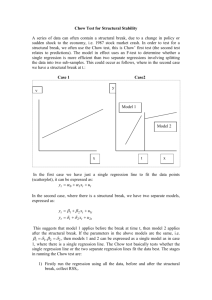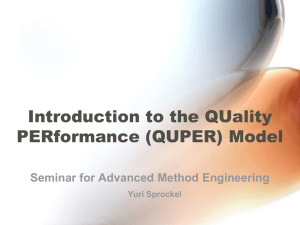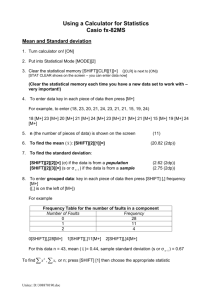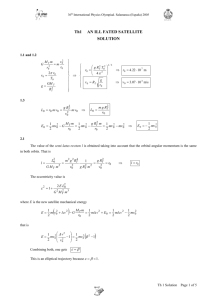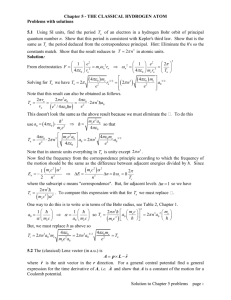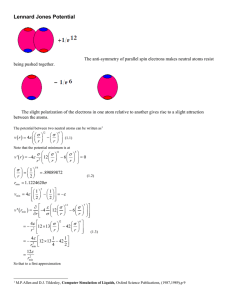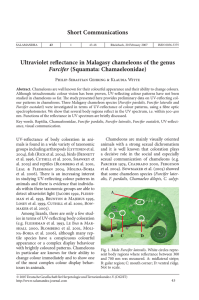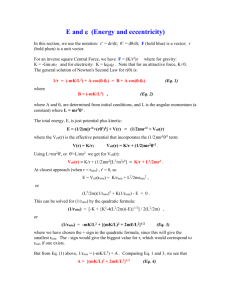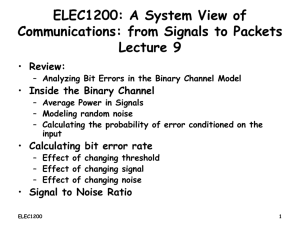Lecture 12 – Testing for Structural Breaks
advertisement
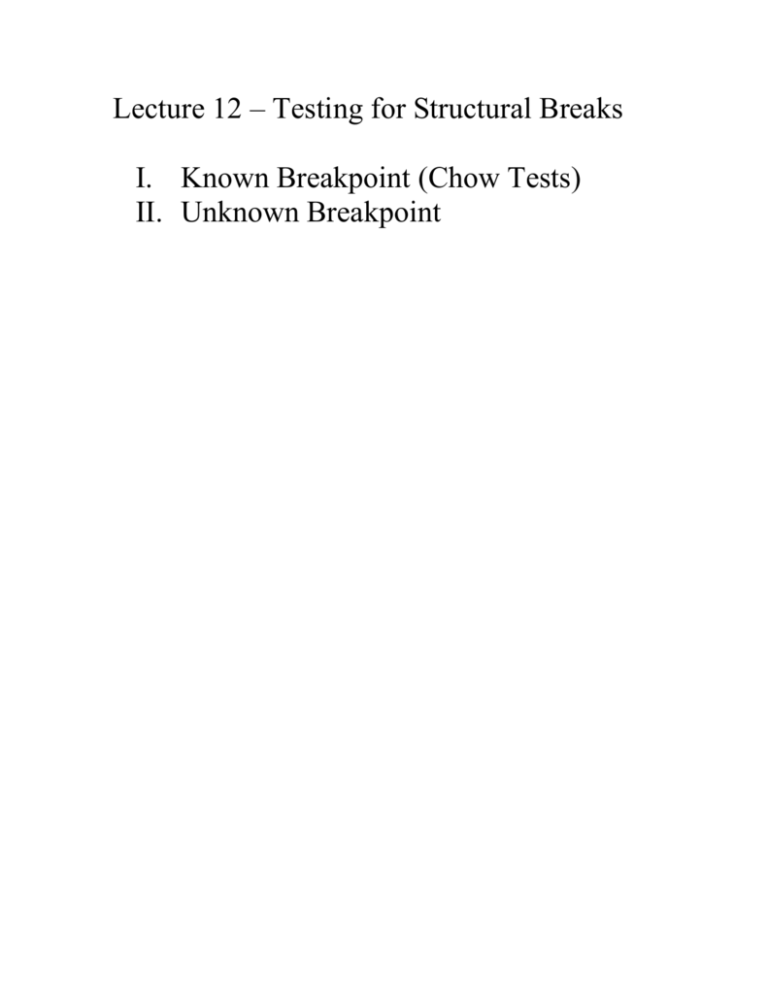
Lecture 12 – Testing for Structural Breaks
I. Known Breakpoint (Chow Tests)
II. Unknown Breakpoint
I. Testing for Structural Change of Known Timing
A. Linear Regression Models
Chow, Econometrica, 1960
B. Nonlinear Econometric Models (including,
but not limited to, nonlinear regression
models)
Andrews and Fair, Rev.of Economic Studies,1988
I.A. Consider a linear regression model for which we
assume that a break in one or more of the parameters
occurred in period τ, e.g.,
yt
= xt’β1 + εt if t = 1,…,τ
= xt’β2 + εt if t = τ+1,…,T
or, more compactly,
(*)
yt = xt’β1 + 1txt’γ + εt , t = 1,…,T
where
1t = 0 if t < τ, 1t = 1 if t > τ,
and
γ = β2-β1
Assume that the x’s are weakly exogenous and the ε’s
are spherical (i.e., homoskedastic and serially
uncorrelated).
Under additional regularity conditions regarding the joint x
and ε process, the OLS estimator of (*) is consistent,
asymptotically normal and asymptotically efficient.
Under the null of parameter stability, i.e., H0: γ = 0,
the standard F-test is asymptotically valid.
Example – Homework Project 1, Part III
I.B. Andrews and Fair (1988) extended the Chow test to
apply in much more general settings –
Nonlinear regression models with serially
correlated and/or heteroskedastic errors (and
weakly exogenous regressors).
A wide class of nonlinear models (other than
regression models) of dependent and
heterogenous processes estimated by a variety of
estimators.
Tese “Chow tests”, which include Wald-like tests, LM-like
tests and LR-like tests depend on the correct specification
of the breakpoint.
Notes The paper is not general enough to cover testing for
structural change in a GMM setting, although
subsequent work by Andrews and others have
provided tests that appropriate in a GMM setting when
the breakpoint is unknown (the known breakpoint
being a special case).
These tests can easily be modified to only allow for
structural break in a subset of the parameters
Although I call these structural break tests, they are
actually test of parameter constancy or homogeneity.
III. Testing for a Structural Break with an
Unknown Break Point
Andrews, Econometrica, 1993
A. Linear Regression Model
Suppose
yt
= xt’β1 + εt , t = 1,…,τ
= xt’β2 + εt , t = τ+1,…,T
β1 , β2, and xt are kx1.There is a single breakpoint,
τ. Assume the x’s are stationary and weakly
exogenous and the ε’s are serially uncorrelated and
homoskedastic.
Consider H0: β1=β2
If τ is known the “F-statistic”
FT(τ) =(T-2k) [SSR1:T –(SSR1:τ + SSRτ+1:T)]/ (SSR1:τ +
SSRτ+1:T)
is asymptotically χ2(k) under H0. (Quandt, 1960,
showed that if the ε’s are normally distributed and
the x’s are strictly exogenous, FT(τ) is the
likelihood ratio statistic and is exactly χ2(k) under
H0.)
In the case where τ is unknown, Quandt (1960)
showed that the likelihood ratio statistic
corresponding to H0: β1=β2 is:
QLRT
max
{ min ,..., max }
FT ( )
Quandt realized that the standard assumptions used
to show that the LR-statistic is asymptotically χ2
did not apply in this setting but he did not know
how to derive (or even show the existence of) the
asymptotic null distribution of QLRT. (Question: If we
use the χ2 distribution do you think that the actual size of
the test will be greater than or less than the nominal size?
I.e., if the null is correct, do you think we will end up
rejecting the null too often or too infrequently? Why?)
This problem was not solved until 30 years later. The
keys to solving the problem were developments in
econometric theory, particularly the theory of unit root
asymptotics, which provided a proper set of tools.
It turned out that the feature of this problem that made it
so complicated was that the nuisance parameter τ is not
identified under the null hypothesis. There are a number
of other settings in which “a nuisance parameter is only
identified under the alternative hypothesis including,
e.g., testing for the presence of threshold effects in
threshold regression models.Thus, the problem of testing
for structural breaks at unknown points has become part
of a much larger literature.
Andrews (1993) showed that under appropriate
regularity conditions, the QLR stastistic, also
referred to as a SupLR statistic, has a “nonstandard
limiting distribution.” In particular, under H0,
QLRT
D
B (r )' Bk (r )
sup
( k
)
r [rmin , rmax ]
r (1 r )
where 0 < rmin < rmax < 1 and Bk(.) is a “Brownian
Bridge” process defined on [0,1]. Percentiles of
this distribution as functions of rmax-rmin and k are
tabulated in Andrews (1993).
Notes –
The applied researcher has to choose rmin and rmax
without much guidance. (Think of rmin as the
minimum proportion of the sample that can be in
the first subsample and think of 1-rmax as
the minimum proportion of the sample that can be
in the second subsample. rmin = 0.1 and rmax= 0.9,
e.g.? This kind of problem arises in most of these
kinds of tests as we will see when discuss
estimating/testing threshold models.
Andrews (1993) also solved the problem of testing
for an unknown break in any setting in which the
GMM estimator can be applied! I.e., the results
for the OLS estimator of the linear regression model
is a special case of a much more general set of
results which provide the limiting null distribution
of the SupLR, SupW and SupLM statistics.
B. Hansen (1997) provides a numerical procedure to
compute asymptotic p-values for these tests.
These tests can be extended to more than one break
point provided the maximum number of possible
breakpoints is known. (Bai and various co-authors).
For more recent developments in this literature: Go
to Dr. Bunzel’s seminar!
